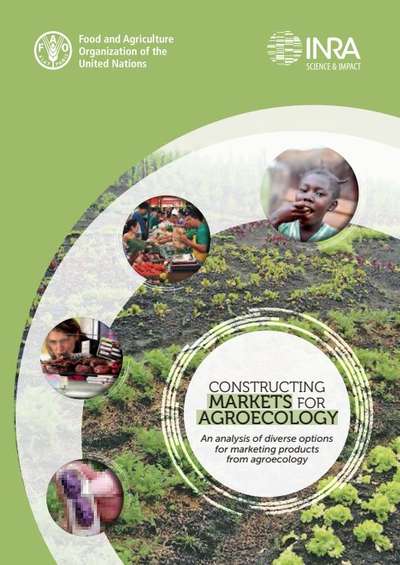Constructing markets for agroecology : an analysis of diverse options for marketing products from agroecology
Loconto, Allison Marie ; Jimenez, A ; Vandecandelaere, Emilie

197 pp. : ill.
INRA Science & Impact
[ Gift of Dr Abram Bicksler Jan 24, 2023 ]
This book examines the emerging phenomenon of markets for “agroecological” products and asks two fundamental questions: (i) do they exist? and (ii) what forms do they take? Based on a meta-analysis of 12 case studies from different ongoing initiatives around the world, we focus on how different types of local actors (producers, consumers and intermediaries) create markets for agroecological products. The results show that markets for agroecological products do exist, but are not always separate from organic markets. Using a conceptual framework from economic sociology, we argue that market channels become agroecological through the specific rules and networks (including material objects such as physical markets, labels and posters) that the initiative has built up to ensure the transmission of knowledge that products are indeed agroecological. This means that they are “work in progress” and cannot be considered as static or completed markets. The resulting market networks have a number of common characteristics: the business models are community based and generally promote a mission to fulfil a social need of the community, participatory decision-making, inclusivity and resource efficiency that goes beyond economic efficiency. The value of agroecological food is found in its characteristics as organic, healthy, natural and safe food that is free from agrochemicals; interviewees focused primarily on the extrinsic organoleptic qualities of the food itself. Market channels for agroecological products are many and diverse – from local on-farm shops to export, with five channels being the most preferred: direct sales, on-farm stalls, farmers’ markets or ecofairs, open-air markets and restaurants. Short food supply chains are common and four types of nested market networks can be distinguished for agroecology: information-rich, interactive, diversified and sociocultural. Direct contact between producers and consumers or contact via trusted intermediaries is the most common means to communicate quality, and labels are important in these initiatives as a means to communicate agroecological quality. Specifically, we found evidence of an important role for consumers who are directly influencing the way products are marketed and a correspondingly increased responsibility being taken by producers to develop their own marketing strategies. The majority of the interviewed producers and consumers explained that the food they consume has changed since they joined their initiatives and reported that this change has had positive effects on their diets and physical and/or mental health. In fact, a lack of agrochemicals and concerns about health were the most used terms to describe the meaning of agroecological food across the cases. Overall, we see evidence that a socio-economic vision of agroecology is emerging in dynamic and diversified nested markets across a range of developing country contexts. Locally defining the marketing terms that refer to “agroecology” is very important, especially for building a shared understanding that can be used to mobilize local actors in the transformation of food systems. Keywords: agroecology, quality, markets, market channels, valuation, business models, sustainability
An important driver for enhancing sustainable food systems lies in agroecology. Following the International Symposium on Agroecology for Food Security and Nutrition organized by FAO in 2014 and subsequent regional symposia, there is now international recognition that agroecology has the potential to facilitate a transition towards more productive, sustainable and inclusive food systems worldwide by enabling countries to produce healthy and nutritious food while protecting the environment and ensuring social inclusion. Regarding the link between sustainable agricultural practices and market exchanges, small-scale and family farmers have demonstrated their significant ability to innovate and collectively find practical solutions to their local sustainability problems in relation to their agricultural and market practices, as highlighted in a recent FAO-INRA study (FAO, 2016a). Building on knowledge about innovative markets for smallholders and agroecology as key modalities towards more sustainable food systems, this study aims at understanding the construction of markets for products from agroecology, from the perspective of supporting the conditions of their emergence and their scaling up. The publication provides a unique approach to understanding how markets are constructed for agroecological products, while at the same time supporting small-scale actors in their existing initiatives for producing and marketing their products from agroecology, in order to contribute to more sustainable food systems.
Publication Details
- Published: 2018
- Publisher: Rome : FAO (Food and Agriculture Organization of the United Nations)
- ISBN-10: 9251303398
- ISBN-13: 978-9251303399
- Dewey Decimal: 658.8
- ECHO Library: 658.8 LOC